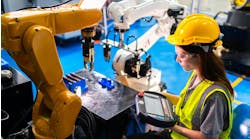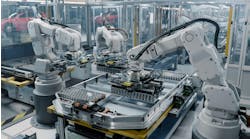“Robots don’t take away jobs. When companies lose to their competition, that’s when workers lose jobs.” These astute comments and others by Jeff Burnstein, president at Association for Automation (A3), were part of a response to a New York Times column written by Thomas B. Edsall that blames robots and artificial intelligence for the displacement of large chunks of Midwestern workers and claims this led to today’s current political divisions. Really?
I think it would be far more entertaining for us all to check out “Alita: Battle Angel,” an epic adventure of hope, empowerment and technology. Like robots and automation, Alita has unique abilities that those in power will stop at nothing to control. This 20th Century Fox film is the futuristic world of Robert Rodriguez, James Cameron and Jon Landau, opening Feb. 14.
Our important connection to technology, past, present and future, will not be stopped.
In his column, Edsall quotes economists at the Massachusetts Institute of Technology and Boston University: “The Midwest and sections of the South have far higher ratios of robots to population than other regions of the United States."
It seems to me Edsall doesn't understand where much of the manufacturing in the United States is located. He should look up where manufacturing contributes well to the U.S. economy and at a higher rate than many other industries. I suggest that robots are highly concentrated in the Midwest and South
"In actuality, robots and automation have saved and created jobs—and will continue to do so," reads Burnstein’s column. I strongly agree.
Burnstein also noted that Edsall has a gross misunderstanding of the role automation plays in the American economy. "Over the last 25 years, many American manufacturers found themselves unable to compete with the lower costs and higher productivity of foreign manufacturers," writes Burnstein. "They closed their doors or moved their operations. Those jobs left for another country. They weren’t taken away by machines."
Burnstein sums it up quite well. "It won’t be robots that take jobs away," he writes. "But it may very well be the lack of robots that costs the American worker."
Burnstein seems to have a great understanding of the role of automation. Unfortunately, others couldn't know less about automation or manufacturing in the United States than if they were standing too close to a robotically tended automatic hydraulic power press that was cycling. Fortunately, controls and mechanical engineers ensure proper safety systems surround the robots and other potentially hazardous automation, protecting all personnel. Let's not try to limit that.
Although not part of the carnage that is often on the front page of newspapers, some when discussing robots seem to immediately default to make things sound bad, apply blame or attack. Unfortunately, I see or hear many examples where unnamed sources, so-called “subject matter experts” or professors at prestigious universities are quoted to add to what I think are often misleading narratives.
I say keep politics out of my automation. If the nontechnical mindset out there tries to tax, slow down or stop its adoption and development, it will just make other countries in the global economy more successful at it. The bottom line is robots are here to stay, and, according to the International Federation of Robotics (IFR), about a half dozen countries are ahead of the United States in robot density in manufacturing industries. We need more robots.
I choose to ignore race, gender or who you voted for when it comes to robotics and automation. All are welcome to the technical family, and even the uneducated and those without college degrees can benefit. Many companies and individuals, including myself, are happy to train you to collaborate with, design, program or maintain robotic systems and related automation. The sky is the limit.
While color and part-type inspection for quality purposes in manufacturing are important, any other considerations of color and type, such as shedding a negative light on automation, is simply a flaw that must be detected and rejected automatically into a transparent bad-part bin. A robot is an excellent tool for this important function.
Embrace these robots and the new ones as they arrive on the plant floor. They are required to modernize manufacturing in the United States, and their application will continue to increase. It's a requirement that cannot be ignored or resisted if strengthening U.S. manufacturing in a global market and bringing some of it back home are important to you. Robotics are big in the automotive industry. Let’s learn from that and increase their use in other U.S. industries. I'll work hard to help and not hinder that.
The golden rule of automation is, if you are going to be involved with it or discuss it, be persistent in ways to ensure its success. Many are counting on you.
As Calvin Coolidge once said, "Nothing in the world can take the place of persistence. Talent will not; nothing is more common than unsuccessful men with talent. Genius will not; unrewarded genius is almost a proverb. Education will not; the world is full of educated derelicts. Persistence and determination alone are omnipotent."
Automate, and find other ways to be competitive. At a minimum, both are required.






